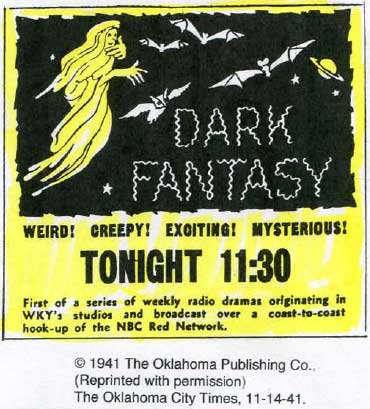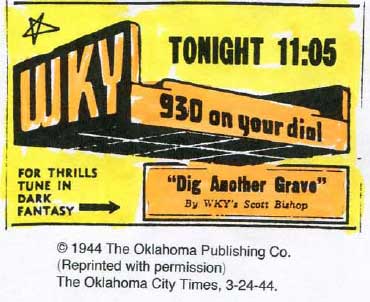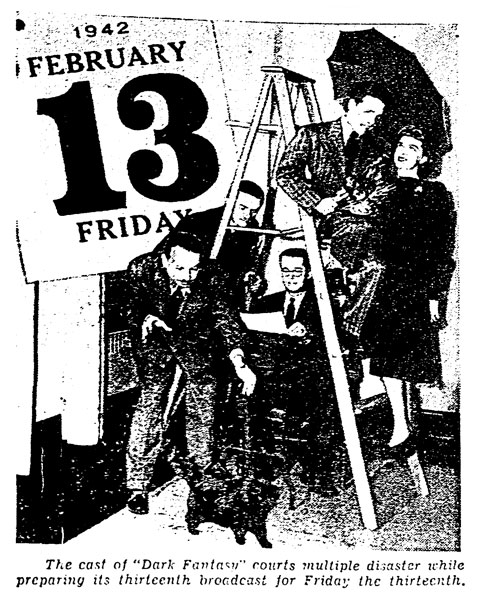|

This story was published in Radio Recall, the journal of the Metropolitan Washington Old-Time Radio Club, published six times per year.
Click here to return to the index of selected articles.
|
|
 SHEDDING LIGHT ON... DARK FANTASY SHEDDING LIGHT ON... DARK FANTASY
Horror Radio from America's Southwest
by Karl Schadow © 2011
(From Radio Recall, February 2011)
Encounters with supernatural beings, mad scientists and adventures in mythical places were just some of the themes featured on the program Dark Fantasy, heard via the WKY, Oklahoma City airwaves in the 1940s. How did this horror anthology get on the air? Who produced it? These questions and the manner in which it has eluded all but die-hard horror fans, will be addressed in this essay.
If one contemplated the thought that of 31 episodes of a network series, 27 were extant, one might assume that most radio reference books in addition to those horror compendiums with radio sections would at least provide a citation for such a program. However, for Dark Fantasy this is not the case. The most glaring examples are John Dunning's Encyclopedia (1998) and “Terror on the Air” by Richard Hand (2006) which cites nearly 100 programs. Moreover, a 1991 Master's Thesis by the late Herman Ellis Meeks on the history of WKY, nor a 1993 history of early Oklahoma radio by Gene Allen mention the program. (Interested readers may contact this author directly for an extensive list of applicable references.) It is encouraging however, to note the recent articles on this program by Bret Jones (2009) and Matthew Killmeier (2010).
When The Billboard announced in October 1941 that NBC was discontinuing its late-night (11 pm-1 am) dance band remotes, an opportunity now existed for its affiliated stations to promote their individual studio programs. This exploited a policy of NBC executives Sidney N. Strotz and Clarence L. Mesner who had always considered ways and means of giving hinterland talent a break. The staff at WKY took full advantage of this policy by airing a program with the title "The Man Who Came Back" at 11:15 pm on Wednesday, October 22, 1941. According to the WKY program listings in The Oklahoma City Times (local evening newspaper), this may have been the audition of what ultimately became Dark Fantasy. This supposition awaits further validation.

What is known and is now being confirmed by definitive sources (see below) is that Dark Fantasy premiered on Friday, November 14, 1941 at 11:30 pm, Central Time (12:30 am, Eastern). Although much of the East Coast was unaware that a new sibling had arrived on the block. Dark Fantasy joined a class of thrillers which included the network programs: Mystery Hall (Mutual) and Inner Sanctum Mysteries (NBC-Blue); and those syndicated in various markets: The Hermit's Cave and The Witch's Tale that could be tuned-in across the country.
Dark Fantasy was publicized as the next generation of horror programs and was frequently compared to its predecessor, Lights Out which had been off the air for two years. WKY was owned by The Oklahoma Publishing Company and as such, was afforded optimal publicity through the Company's two daily newspapers: The Daily Oklahoman (morning and Sunday) and the aforementioned Times. With the inauguration of Dark Fantasy, both newspapers promoted the Lights Out comparison and the WKY staff including the team of George M. Hamaker (author) and John Prosser producer/director. A similar announcement in the November 17, 1941 issue of Broadcasting indicated that Dark Fantasy was produced by John I. Prosser with George H. (sic) Hamaker writing the script.
An amusing letter appeared in the December 20-26, 1941 issue of Movie-Radio Guide submitted by George M. Hamaker stating that Dark Fantasy, a new series was being written by Scott Bishop. This letter was in response to a previous month's (note the timing) inquiry by a Chicago Lights Out fan club that was pondering the fate of its favorite and similar type programs.
Those of you familiar with Dark Fantasy may have caught what seems to be a contradiction as the name Scott Bishop has been pseudonymous with this program. Scott Bishop was the pseudonym and "adopted" real name of George Marion Hamaker. According to his widow Mrs. Dores Hatfield, George's name was changed (although not legally) to Scott Bishop as the result of the name Hamaker being enunciated by an announcer as HEY-maker, the author of one of George's plays. One wonders what the announcer was called following this incident?
George Hamaker, a native of Kansas was born on May 21, 1912. He attended St. Mary's College in St. Mary's Kansas, wrote pulp stories and acted in legit theater before joining Topeka station WIBW in the early 1930s. He authored many scripts for the station including those for the locally broadcast WIBW Players and The Crime Patrol, a mystery series heard on the Kansas Network. His writings were featured on several network programs: Grand Hotel, First Nighter, Grand Central Station, Silver Theater and the "notable" Lights Out. Other than "Firing Squad" (September 9, 1938), on Firs t Nighter, titles of the other programs are still being sought. In 1936, Hamaker moved to Oklahoma City where was employed as a member of the WKY continuity staff, becoming its chief in 1938 in addition to duties acquired as publicity director.
Among the plethora programs he penned at WKY were Tales of The Witch Queen, a five-a-week thriller and the daytime serial, The Heart of Martha Blair. Just prior to Dark Fantasy, he brought back The Crime Patrol series under the title, Calling Detective O'Leary. In 1943, he penned The Strange Dr. Karnac for the now rival Blue Network. Although many sources cite him as a contributor to The Mysterious Traveler and The Sealed Book, titles have not been located, thus confirmation awaits. Of special note is the 1942-43 series, Unknown Allies, where his scripts were produced by soldiers at Camp Grant and broadcast over the neighboring station WROK in Rockford, Illinois. John I. Prosser joined WKY as program director in 1941 after stints at various stations and also as a member of the advertising agency, N.W. Ayer & Sons.

Each episode of Dark Fantasy was a complete story in itself with no recurring characters. The cast was composed of WKY staff members and additional Oklahoma City talent. Ben Morris and Eleanor Naylor Caughron were most often heard in leading roles. Charles Carshon and Alf Daniels filled in on occasion for Ben Morris, while Georgianna Cook and Erma Rae did like wise for Mrs. Caughron. Of special note is the appearance of stage and screen star Jane Wyatt in "Debt of the Past" (January 16, 1942). On that day, Miss Wyatt was one of the headliners in Oklahoma City's Mile-o-Dimes campaign festivities to combat infantile paralysis.
The supporting players on Dark Fantasy were: Minnie Jo Curtis, Muir Hite (also specialist in animal imitations), WKY Traffic Manager Daryl McAllister (also the resident sound effects expert), Fred Wayne, Eugene Francis, Murillo Schofield, Garland Moss, George Ande, Bloyce Wright and Don Stolz, who, at age 93 is the owner (for over sixty years) of the one of America's most prominent entertainment facilities, The Old Log Theater in Excelsior, Minnesota. Additional members comprising the production staff for Dark Fantasy included: Charles Purnell and Doug Fleming sound effects artists, and Ken Wright providing mysterioso music on the Kilgen Organ. Keith Painton announced the first five episodes with Tom Paxton carrying those duties for most of the remainder of the series.
 |
| Cast of Dark Fantasy defying superstition for the program's 13th episode, "W is for Werewolf" to be aired Friday, February 13th. L-R: animal imitator Muir Hite chasing cat, under the ladder producer John I. Prosser overseeing author Scott Bishop, and on ladder, sound man Charles Parnell and actress Eleanor Naylor Caughron. Photo from the February 13, 1942 issue of The Daily Oklahoman. Used with permission of The Oklahoma Publishing Company. |
At its inception, Dark Fantasy was promoted as being the first dramatic series to be aired in the history of the NBC-Red Network which had not originated at The Big Three (New York, Chicago, Hollywood). Oops, someone needed to review the logs as recently as the previous spring to discover that WTIC (Hartford, Connecticut) aired its Guy Hedlund Players in a 13-week Saturday afternoon series, 2:30 pm on WKY.
Not withstanding, WKY was no novice in originating network programs of a musical variety. Since January 21, 1939 when Southwestern Stars debuted on the NBC-Blue (two months later switched to the Red) the station produced five additional Red Network programs: Cameos of Melody, Southwestern Serenade, Summertime Swing, Campfire Embers and Southern Rivers. Most of these commenced as local productions later achieving national status.
As previously mentioned, the initial network performance of Dark Fantasy was November 14, 1941. Definitive sources providing confirmation are the NBC Master and Traffic Books for Station WEAF from the NBC Collection at The Library of Congress. These logs are an astute documentation of the actual programs aired on any given day while also indicating which stations or group of stations carried the programs. For most days, the Traffic Books provided an episode title, while a few included a copy of the script stamped 'Approved for Broadcast.' These are not to be confused with the corrected 'As Broadcast' copies of the scripts.
Depending upon which announcer was assigned to the New York Studios for that particular evening, one might even find a cast member or two, but most often no extra tidbits of information. Alternatively, press releases provided to newspapers by the network indicated what was planned to be broadcast for a given day, usually seven to ten days in advance. Some newspapers did not include radio program listings past midnight, while others provided a complete, though less detailed log. A good example of this latter group is The New York Times. The name, Dark Fantasy or simply an episode title did not appear in the listings until January 23, 1942, the tenth episode. However, several other New York City newspapers listed Dark Fantasy throughout its entire run. It behooves all OTR researchers to check multiple sources and verify information. It is unknown how the myth started that Dark Fantasy did not achieve network status until January 2, 1942. Finally, this myth has been debunked.
Following the close of the network run on June 19, 1942, WKY announced in the trade publication Radio Daily that is was offering the entire series on a syndicated basis to local stations, ad agencies and potential sponsors. This offer was repeated in 1943. A one-time listing (October 20, 1942) in The Hutchinson, Kansas News suggests that Dark Fantasy may have been aired. Additional research is warranted.
From February 17, 1944 to April 12, 1944, a new, nine-week local series of the program was produced by WKY. Other than titles of two episodes (different from the original series) and the identity of the production team of Prosser and Bishop, little has been unearthed regarding this intriguing chapter of the Dark Fantasy saga.
The next issue of Radio Recall will provide an extensive broadcast log and detailed plot analysis revealing the horrific nature of this program.
|